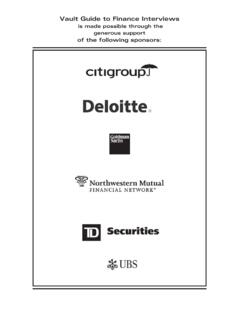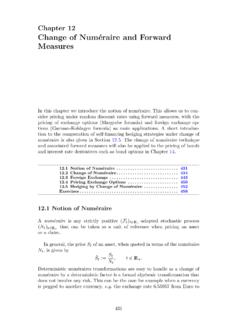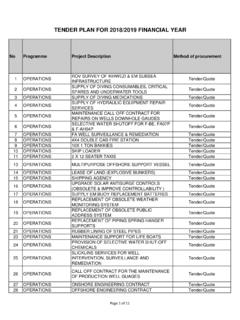Transcription of Regulation now: the new standard - EY - United States
1 Regulation now: the new standard and how firms are adapting2015 Federal Reserve regulatory reporting survey21 Regulation now: the new standard and how firms are adapting2 ContentsPurpose and approach1 Survey highlights2 Introduction5 Key themes:Organizational structure6 Report preparation11 Data and technology18 Governance and controls24 Intermediate Holding Company rule37 Conclusion4321 Regulation now: the new standard and how firms are adaptingPurpose and approachIn 2012, EY published a bank financial regulatory reporting survey of many of the largest US bank holding companies (BHCs) and foreign banking organizations (FBOs). The survey focused on organizational and process functions within the regulatory reporting department (RRD), as well as interactions with other groups involved in supporting the bank financial regulatory reporting process, such as risk, quality assurance and 2015, EY is refreshing this survey to track developments and gauge new challenges facing the RRD.
2 The survey incorporates new questions for FBOs relating to the impact of the Intermediate Holding Company (IHC) rule and an enhanced focus on regulatory reporting governance. The survey consisted of 68 questions, of which a selection is included in this report. These questions are aimed at understanding the regulatory reporting environment and identifying industry trends and practices with respect to the regulatory reporting operating model. Twenty-five US BHCs and FBOs were surveyed. EY would like to extend our thanks to the participants of the now: the new standard and how firms are adaptingRespondents reported that hiring resources with sufficient regulatory reporting experience was among their biggest challenges. Departments other than RRDs are playing a significant part in report ownership, most notably for structural reporting and the FR Y-14 series (FR Y-14A, FR Y-14Q and FR Y-14M).Organizational structure>50% Since 2012, firms have continued to spendof their time preparing regulatory reports versus performing analysis and preparationRRDs have expanded to adapt to new reporting requirements and heightened regulatory highlightsof survey respondents indicated that they had fewer than five full-time employees dedicated to analytics and review.
3 60%of respondents noted that both RRD and the business units share responsibility for providing supporting documentation for both report preparation and manual use of analytical procedures beyond variance analysis has, increased as firms are using peer benchmarking, ratio analysis and other metrics to monitor completeness of now: the new standard and how firms are adaptingData and technology56%2of firms use a central data source for some reports, most notably the FR Y-9C and Call Report, representing an 11% increase since the greatest challenges faced by firms: Managing data quality Maintaining data granularityof respondents reported that their regulatory reporting process is partially firms describe their data quality as being medium level, requiring RRD to perform detective controls in an effort to identify data errors prior to report and controls56%of survey respondents have established regulatory reporting committees to review regulatory reports, discuss issues facing the firm and enforce accountability, partially driven by Federal Reserve expectations resulting from recent examinations and related leading-practice survey respondents incorporate a formal attestation process to cover data provided by groups supporting the reporting process, of which 71% use a tool to facilitate the attestation process.
4 88%of survey respondents update their RRD policies and procedures on a regular basis, either quarterly or of IHC ruleIn 2014, the Federal Reserve finalized rules for FBOs to implement enhanced prudential standards (EPS). The EPS rule is not explicit on the application of regulatory reporting requirements for the IHC. However, it is expected that IHCs would be subject to a similar regulatory reporting regime as US FBOs are facing significant data sourcing challenges in meeting anticipated IHC regulatory reporting now: the new standard and how firms are adaptingCComposition of reporting panel total assetsComposition of reporting panel firm designation52%28%20%68%32%< $150b$150-$500b> $500bBHCFBOThe composition of firms that participated in the 2015 survey is included below45 Regulation now: the new standard and how firms are adaptingThe global regulatory reform agenda continues to drive change in the finance function, as well as require finance and risk functions to jointly address increasing and overlapping requirements.
5 In the US, new and complex regulatory requirements, including the Comprehensive Capital Analysis and Review (CCAR) and Basel III, and key organizational legal-entity structure changes for FBOs ( , IHC) have broad implications for organizations and will require the implementation of significant enhancements across the operating must consider current and planned initiatives to develop scalable and sustainable solutions to address evolving Federal Reserve financial reporting requirements. EY s 2015 Federal Reserve regulatory reporting survey provides an overview of the current regulatory reporting practices of 25 of the leading US BHCs and FBOs. The results reveal that institutions subject to Federal Reserve financial reporting requirements are expanding the role of RRDs as well as relying on involvement from other functions across the organization, specifically risk, treasury, operations, technology and legal. Based on results of the survey, the primary regulatory reporting challenges faced by institutions continue to center around adapting to the pace of regulatory change and more specific challenges related to a number of key organizational and functional areas, including: Organizational structure Departments other than the RRD (compliance, internal audit, quality assurance, risk and treasury) play a significant role in report ownership of financial regulatory reports.
6 Report preparation Preparation of regulatory reports currently requires significant time, resources and manual intervention to meet requirements and reduces the time firms have available for review and analysis. Data and technology In the context of rapidly changing Federal Reserve reporting requirements, key data and technology challenges include managing data infrastructure that incorporates multiple independent sources and systems that support the production of high-quality reconciled data at sufficient levels of granularity. Governance and controls An enhanced focus by regulators on the establishment of an accountability framework and other controls over the reporting process, including formal attestation and regulatory reporting oversight committees, is driving firmwide accountability. IHC Enhanced Prudential standards (EPS) will require significant finance transformation across FBOs entire US operations and organizational legal-entity survey has been grouped according to these five areas of now: the new standard and how firms are adaptingOrganizational structureThe evolving regulatory landscape continues to stress the need for institutions to report increasingly granular data with greater frequency, challenging organizations to meet this demand while providing high-quality information.
7 This pressure has forced institutions to rethink their organizational structure and strengthen cross-functional cooperation in order to enable RRDs to keep pace with regulatory reporting findingsffRespondents reported that hiring resources with sufficient regulatory reporting experience was among their biggest challenges. ffDepartments other than the RRD are playing a significant part in report ownership, most notably for structural reporting and the FR Y-14 series (FR Y-14A, FR Y-14Q and FR Y-14M).67 Regulation now: the new standard and how firms are adaptingCross-functional ownership exists across several key Federal Reserve financial reports for banks.*The majority of US bank and holding company regulatory reports are prepared by RRDs. However, numerous departments outside of RRD, most notably legal and treasury, provide data for regulatory reports that are relevant to those groups. Departmental ownership of the FR Y-14 series varies across institutions and is discussed percent of respondents reported that the legal department owns organizational structure reporting (FR Y-10, FR Y-6, FR Y-7), with 60% of respondents reporting that legal-entity structure changes were the responsibility of the legal department.
8 Treasury was also cited as a common owner of regulatory reports, including Treasury International Capital (TIC) reports and, more often, the FR 2052 and FR 2420, which is filed by the treasury function by 33% of the respondent is also responsible for a myriad of other reports, including FR 2028, FR 2900, FR 2644, FR Y-15, FR Y-12, FR Y-8, FFIEC 009 and FFIEC 101. Other departments outside of RRD also own additional reports, including the FR 2004 (operations).Q: Are certain reports owned by departments/groups other than RRD?*Financial reportReport nameFR Y-9 CConsolidated Financial Statements for Holding CompaniesCall ReportFFIEC 031 Consolidated Reports of Condition and Income for a Bank with Domestic and Foreign OfficesFFIEC 041 Consolidated Reports of Condition and Income for a Bank with Domestic Offices OnlyFFIEC 002 Report of Assets and Liabilities of Branches and Agencies of Foreign BanksF R Y-11 Financial Statements of Nonbank Subsidiaries of Holding Companies FR Y-7 NFinancial Statements of Nonbank Subsidiaries Held by Foreign Banking Organizations FR 2314 Financial Statements of Foreign Subsidiaries of Banking OrganizationsF R Y-10 Report of Changes in Organizational StructureFR Y- 6 Annual Report of Holding CompaniesF R Y-7 Annual Report of Foreign Banking Organizations TIC reportsTreasury International Capital System forms filed by Banks and Non-financial FirmsFR 2052 Complex Institution Liquidity
9 Monitoring Report FR 2420 Report of Selected Money Market Rates FR 2028 Survey of Terms of Business LendingFR 2900 Report of Transaction Accounts, Other Deposits, and Vault CashFR 2644 Weekly Report of Selected Assets and LiabilitiesF R Y-15 Banking Organization Systemic Risk ReportFR Y-8 Bank Holding Company Report of Insured Depository Institutions Section 23A Transactions with AffiliatesFFIEC 009 Country Exposure ReportFFIEC 101 Regulatory Capital Reporting for Institutions Subject to Advanced Capital Adequacy FrameworkF R Y-12 Consolidated Holding Company Report of Equity Investments in Nonfinancial Companies 120%100%80%60%40%20%0%FR Y-9C/ Call ReportFR Y-11, Y-7N, 2314FR Y-10, Y-6/Y-7 TIC reportsFR 2052100%95%5%36%56%8%90%5%5%60%33%7%Regu latory reportingLegalTreasuryFinanceOther89 Regulation now: the new standard and how firms are adaptingDepartmental ownership of the FR Y-14 series varies across FR Y-14 series is handled by newly formed units within finance and risk, while RRDs maintain responsibility for more mature bank financial regulatory reports, such as the FR Y-9C.
10 Forty percent of respondents reported that the FR Y-14A, Q and M are owned by several different departments, including the RRD, treasury and finance . The lack of centralized data sources and ownership results from complex reporting requirements, including granular data and the forward looking nature of projections required on the FR Y-14A. Leading practices include firmwide awareness and involvement in the regulatory reporting process. Accountability for data integrity is strengthened by including departments outside of the RRD in report table below lists the top five owners reported for the FR Y-14 series of reports:1. Regulatory reporting2. Finance3. Treasury4. Capital planning/reporting5. ControllersFR Y-14 ownershipFR Y-14M/QFR Y-14A1. Capital planning/reporting2. Treasury3. Regulatory reporting4. Finance5. Risk89 Regulation now: the new standard and how firms are adapting50%33%17 %> $500b31%15%54%< $150bForty-six percent of respondents have RRDs consisting of more than 20 full-time employees (FTEs).
















